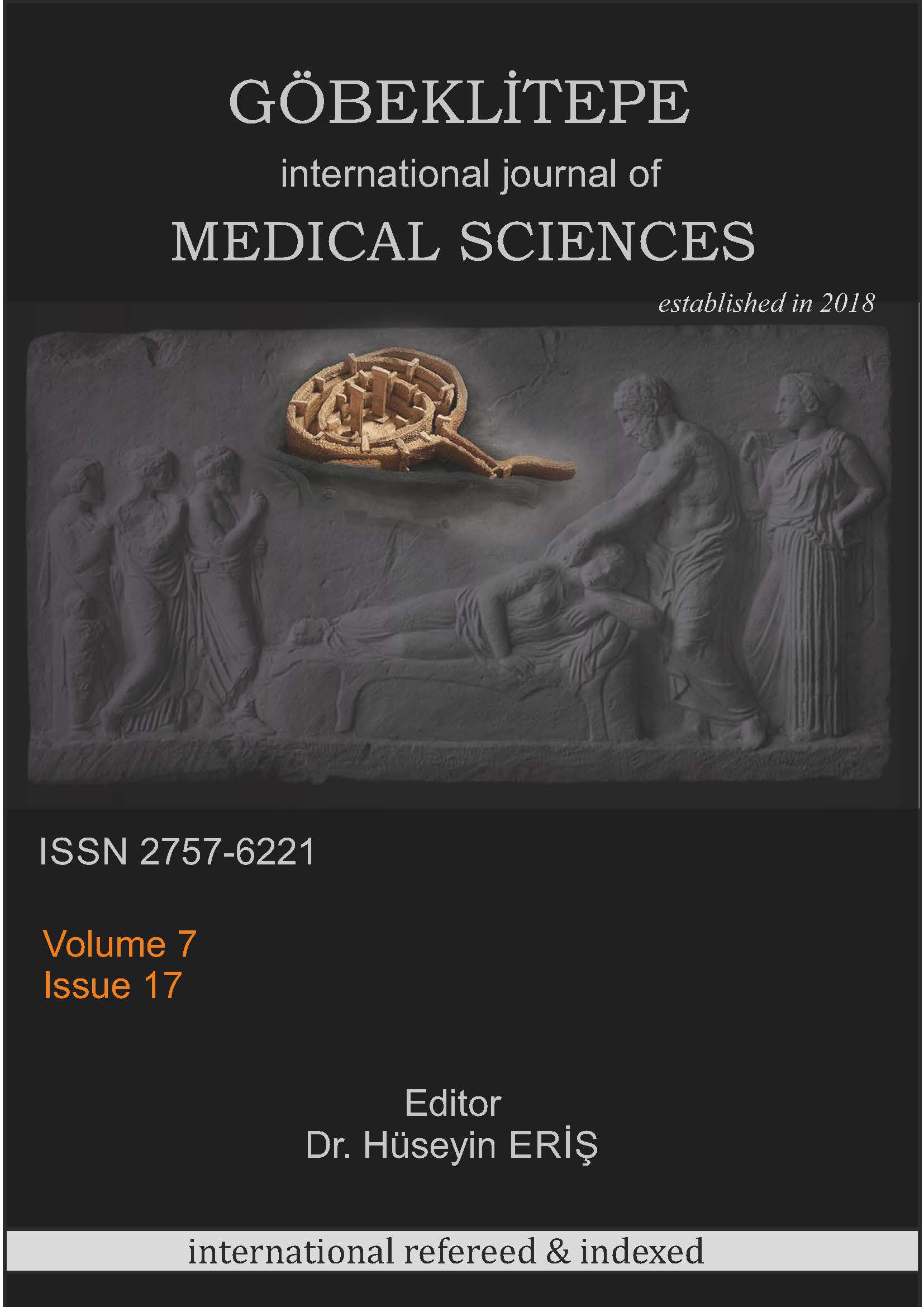EFFECTS OF DRY HEAT APPLICATION ON MENSTRUAL SYMPTOMS AND PAIN: A RANDOMIZED CONTROLLED TRIAL
Keywords:
Menstruation, hot pack application, pain, nursingAbstract
Heat application can be effective method on premenstrual symptoms. This study was to determine the effect of dry heat applied on foot base menstrual symptoms and pain. In this randomized controlled trial, the effectiveness of the hot application to the foot base of the students was evaluated in 2019. Data were collected via sociodemografic form, Visual Analog Scale (VAS) and Menstruation Symptom Questionnaire [MSQ]. In the first three days of the menstrual period which the pain is more intense, the participants should have dry hot application when they feel pain; two times in a day pain was assessed with VAS and in the last day of the menstruation MSQ was filled. A statistically significant difference was found between the three-day VAS in both groups. However, there was no difference between Menstruation Symptom Scale subscale and total score avg of the intervention and control groups. Applying hot pack to the foot can be expressed as an effective method to reduce pain. Due to premenstrual syndrome is a complex process, the reduction of pain in the later days of the menstrual cycle in both groups can be psychological or be explained for physiological reasons. Clinical Trial Registration:NCT05664048.
References
Arıöz, A., & Ege, E. (2013). Premenstrüal sendrom sorunu olan üniversite öğrencilerinde, semptomların kontrolü ve yaşam kalitesinin arttırılmasında eğitimin etkinliği. Genel Tıp Dergisi, 23(3), 63-69.
Dickerson, L.M., Mazyck, P.J., & Hunter, M.H. (2003). Premenstrüal syndrome. American Family Physician, 67(8), 1743-1752.
Indusekhar, R., Umsan, S.B., & O’Brien, S. (2007). Psychological aspects of premenstrüal syndrome. Best Practice & Research Clinical Obstetrics and Gynaecology, 21(2), 207-220.
Karaca, P.P., & Beji, N.K. (2015). Premenstrüal sendromunun tanı ve tedavisinde kanıt temelli yaklaşımlar ve hemşirelik bakımı. Balıkesir Sağlık Bilimleri Dergisi, 4(3), 178-186.
Temel, S., Terzioglu, F., & Koc, G.I. (2018). Premenstrüal syndrome in university students: Its correlation with their attitudes toward gender roles, Journal of Psychosomatic Obstetrics & Gynecology, 39(3), 228–236.
Topçuoğlu, M.A., & Koç, Ö. (2009). Premenstruel sondrom ve premenstruel disforik bozukluk. Haseki Tıp Bülteni, 47(2), 5-9.
Doğan, S., Doğan, N., Can, H., & Alaşehirlioğlu, H.V. (2012). Birinci basamakta premenstrüal sendroma yaklaşım. Smyrna Tıp Dergisi, 1, 90-93.
https://tez.yok.gov.tr/UlusalTezMerkezi/ , Erişim Tarihi: 22.11.2018.
Yonkers, K.A., O’Brien, P.M.S., & Eriksson, E. (2008). Premenstrüal Syndrome. Lancet, 371(9619), 1200-1210.
Akkus, M., Tamer, K., & Cetin, E. (2017). Investigating the effect of premenstrüal syndrome in high school students doing regular sports. International Journal of Human Sciences, 14(4), 3379-3388.
Parker, M.A., Sneddon, A.E., & Arbon, P. (2010). The menstrüal disorder of teenagers (MDOT) study: Determining typical menstrüal patterns and menstrüal disturbance in a large populationbased study of Australian teenagers. BJOG, 117 (2), 185–192.
Öztürk, S., & Tanrıverdi, D. (2010). Premenstrüal sendrom ve başetme. Anadolu Hemşirelik ve Sağlık Bilimleri Dergisi, 13(3), 57-61.
Özerdogan, N., Sayiner, D., Ayranci, U., Unsal, A., & Giray, S. (2009). Prevalence and predictors of dysmenorrhea among students at a university in Turkey, International Journal of Gynecology and Obstetrics, 107, 39–43.
Aşcı, Ö., Süt, H.K., & Gökdemir, F. (2016). Üniversite öğrencilerinde premenstrüal sendrom prevalansı ve risk faktörleri. Dokuz Eylül Üniversitesi Hemşirelik Fakültesi Elektronik Dergisi, 9(3), 79-87.
Fu, Y.-L.; Yang, C.-L.; Yu, S.-C.; Lin, Y.-H.; Hsu, H.-P.; Huang, C.-M. (2021). Nursing Students’ Perceptions of Menstrual Distress during Clinical Practice: A Q-Methodology Study. Int. J. Environ. Res. Public Health, 18(6), 3160. https://doi.org/10.3390/ ijerph18063160.
Demir, S.C., Kadayıfçı, T.O., & Vardar, M.A. (2000). Dysfunctional uterine bleeding and other menstrüal problems of secondary school students in Adana, Turkey. J Pediatr Adolesc Gynecol., 13(4), 171-175.
Karaman, H.I.O., Tanriverdi, G., & Degirmenci, Y. (2012). Subjective sleep quality in premenstrüal syndrome. Gynecological Endocrinology, 28(8), 661–664.
Ju, H., Jones, M., & Mishra, G. (2014). The prevalence and risk factors of dysmenorrhea. Epidemiologic Reviews, 36, 104–113.
Muluneh, A.A., Nigussie, T.S., Gebreslasie, K.Z., Anteneh, K.T., & Kassa, Z.Y. (2018). Prevalence and associated factors of dysmenorrhea among secondary and preparatory school students in Debremarkos town, North-West Ethiopia. BMC Women's Health, 18(57), 1-8.
Ghanghoriya, V., Patel, K., & Markam, R. (2018). Prevalence of dysmenorrhoea and its effect on quality of life among nursing students. International Journal of Reproduction, Contraception, Obstetrics and Gynecology, 7(6), 2129-2135.
Gagua, T., Besarion, T., & Gagua, D. (2013). Pain and quality of life of adolescents with primary dysmenorrhea in Tbilisi, Georgia, 2008. Cross sectional study, Revista Colombiana de Obstetricia y Ginecología, 64(2), 100-106.
Balbi, C., Musone, R., & Menditto, A. (2000). Influence of menstrüal factors and dietary habits on menstrüal pain in adolescence age. Eur J Obstet Gynecol Reprod Biol., 91(2), 143-148.
Grandi, G., Ferrari, S., Xholli, A. Cannoletta, M., Palma, F., Romani, C., Volpe, A., & Cagnacci, A. (2012). Prevalence of menstrüal pain in young women: What is dysmenorrhea?. Journal of Pain Research, 5, 169–174.
Banikarim, C., Chako, M.R., & Kelder, S.H. (2000). Prevalence and impact of dysmenorrhoea on hispanic female adolescents. Arch Pediatr Adolesc., 154, 1226–1229.
Dereli Yılmaz, S., (2019). Dismenore, in: Karaca Saydam, B., (Eds.), Olgularla Jinekolojik Hastalıklarda Bakım, Ankara Nobel Tıp Kitap Evleri, 2. Baskı, Ankara. pp: 30-33.
Karout, S., Soubra, L., Rahme, D., Karout, L., Khojah, H.M.J., Itani, R. (2021). Prevalence, risk factors, and management practices of primary dysmenorrhea among young females. BMC Womens Health, 21(1):392. doi: 10.1186/s12905-021-01532-w.
Temizkan, S., Budak, M.(2021). The Effects of Kinesiological Taping and Aerobic Exercise in Women with Primary Dysmenorrhea: A Randomized Single-Blind Controlled Trial, 08 December 2021 PREPRINT (Version 1) available at Research Square : https://doi.org/10.21203/rs.3.rs-455920/v1.
Sıcak ve Soğuk Uygulama Teknikleri, MİLLİ EĞİTİM BAKANLIĞI, (2012) http://www.megep.meb.gov.tr/mte_program_modul/moduller_pdf/s%c4%b1cak%20ve%20so%c4%9fuk%20uygulama%20teknikleri.pdf , Ankara. ET. 15.11.2018.
Sağkal Midilli T., Yasar, E., & Baysal, E. (2015). Dysmenorrhea characteristics of female students of health school and affecting factors and their knowledge and use of complementary and alternative medicine methods, Holistic Nursing Practice, July/August, 194-204.
Choi, J.H., (2017). Effects of kinesio taping and hot packs on premenstrüal syndrome in females. The Journal of Physical Therapy Science, 29, 1514–1517.
Jo, J., & Lee, S. H. (2018). Heat therapy for primary dysmenorrhea: A systematic review and meta-analysis of its effects on pain relief and quality of life. Scientific Reports, 8(1), 16252.
Elkin, N. (2015). Sağlık bilimleri yüksekokulu öğrencilerinde premenstrüal sendrom görülme sıklığı. Adıyaman Üniversitesi Sağlık Bilim Dergisi, 1(2), 94-110.
Alsaleem, M. A. (2018). Dysmenorrhea, associated symptoms, and management among students at King Khalid University, Saudi Arabia: An exploratory study. Journal of Family Medicine and Primary Care, 7(4), 769-774.
Chesney, M.A., & Tasto, D.L. (1975). The development of the Menstrüal Symptom Questionnaire. Behaviour Research and Therapy, 13, 237-44.
Negriff, S., Dorn, L.D., Hillman, J.B., & Huang, B. (2009). The measurement of menstrüal symptoms; Factor structure of the menstrüal symptom questionnaire in adolescent girls. Journal of Health Psychology, 14(7), 899–908.
Güvenç, G., Seven, M., & Akyüz, A. (2014). Menstrüasyon Semptom Ölçeği’nin Türkçe’ye uyarlanması. TAF Preventive Medicine Bulletin, 13(5), 367-374.
Gençdoğan, B. (2006). Premenstrüal sendrom için yeni bir ölçek. Türkiye’de Psikiyatri, 8, 81-87.
Potur, D.C., & Komurcu, N. (2014). The effects of local low-dose heat application on dysmenorrhea. J Pediatr Adolesc Gynecol., 27, 216–221.
http://content.lms.sabis.sakarya.edu.tr/Uploads/66704/50713/abdomen_acillerde_hem%C5%9Firelik_bak%C4%B1m%C4%B1_n.%C3%A7%C4%B1nar_2016.pdf Erişim Tarihi: 22.11.2018
Vaghela, N., Mishra, D., Sheth, M., & Dani, V.B. (2019). To compare the effects of aerobic exercise and yoga on Premenstrual syndrome. Journal of Education and Health Promotion, 8,199.
Parikh, H., Khokhar, S.M., Kazi, S.A. (2021). Comparitive Study of Effect of Moist Pack V/S Effect of Core Strengthening Exercises in Primary Dysmenorrhea for Three Consecutive Months, Indian Journal of Physiotherapy and Occupational Therapy, 15(4), 32-38.
Duman, N.B., Yıldırım, F., Vural, G. (2022). Risk factors for primary dysmenorrhea and the effect of complementary and alternative treatment methods: Sample from Corum, Turkey. Int J Health Sci (Qassim), 16(3),35-43.
Paul, M. M., & Rajan, J. K. Effectiveness of Selected Intervention on dysmenorrhoea among adolescent girls at selected colleges in Indore. Journal homepage: www. ijrpr. com ISSN, 2582, 7421.
Hasanpour, M., Mohammadi, M.M., & Shareinia, H. (2019). Effects of reflexology on premenstrual syndrome: A systematic review and meta-analysis. BioPsychoSocial medicine, 13(1), 25.
Kwan, I., & Onwude, J.L. (2015). Premenstrual syndrome. BMJ Clinical Evidence, 0806,1-13.
Gun, C., Demirci, N., & Otrar, M. (2014). Dismenore yönetiminde tamamlayıcı alternatif tedavileri kullanma durumu, Spatula DD, 4(4):191-197.
Potur, D.C., Bilgin, N.C., & Kömürcü, N. (2013). Prevalence of dysmenorrhea in university students in Turkey: effect on daily activities and evaluation of different pain management methods. Pain Management Nursing, 11:1-10. doi: 10.1016/j.pmn.2013.07.012.
Şentürk Erenel, A., & Şentürk, İ. (2007). Sağlık meslek lisesi öğrencilerinin dismenore yaşama durumları ve dismenore ile baş etmeye yönelik uygulamaları. Hacettepe Üniversitesi Hemşirelik Fakültesi Dergisi, 14(2), 48-60.
Roberts, S.C., Hodgkiss, C., DiBenedetto, A., & Lee, E.C. (2012). Managing dysmenorrhea in young women. The Nurse Practitioner, 37(7), 47-52.
Dorn, L. D, Negriff, S., Huang, B., Pabst, S., Hillman, J., Braverman, P., & Susman, E. J. (2009). Menstrüal symptoms in adolescent girls: Association with smoking, depressive symptoms and anxiety. Journal of Adolescent Health, 44, 237–243.
Öksüz, E., & Guvenc, G. (2018). Relationship of premenstrual and menstrual symptoms to alexithymia among nursing students. Perspectives in psychiatric care, 54(3), 391-397.
Derya, Y.A., Erdemoğlu, Ç., & Özşahin, Z. (2019). The status of having the menstrual symptom in unıversity students and its effect on quality of life. Acıbadem Üniversitesi Sağlık Bilimleri Dergisi, 10(2), 176-181.
Sakar, T., Çapık, A., & Akkaş, M., (2019). Ebelik Öğrencilerinde Menstruasyon Dönemine Yönelik Semptomların Değerlendirilmesi. Anadolu Hemşirelik ve Sağlık Bilimleri Dergisi, 22(1), 25-32.
Türkmen H, Yörük S. Effects of Heat Treatment On Dysmenorrhea and Its Mental Health Outcomes: A Randomized Clinical Trial. Psychiatric Annals. 2023;53(6):270-281. doi:10.3928/00485713-20230506-01
Cheng, S.H., Shih, C.C., Yang, Y.K., Chen, K.T., Chang, Y.H., & Yang, Y.C. (2013). Factors associated with premenstrüal syndrom. A survey of new female university students. Kaohsiung Journal of Medical Sciences, (29), 100-105.
Downloads
Published
Versions
- 2024-11-12 (4)
- 2024-11-12 (3)
- 2024-10-24 (2)
- 2024-09-27 (1)
How to Cite
Issue
Section
License
Copyright (c) 2024 Göbeklitepe Sağlık Bilimleri Dergisi

This work is licensed under a Creative Commons Attribution 4.0 International License.




